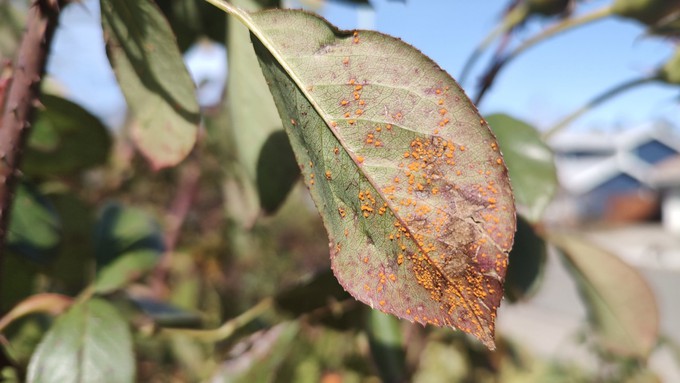
How to tackle fungal outbreaks on roses without spraying

This rose is in the grip of the fungal disease known as rust. Cleanup and warmer weather will end the outbreak. Debbie Arrington
It’s easy to spot: This colorful fungal disease gets its apt nickname from the bright orange spores that form on the underside of leaves. The top surface of foliage becomes speckled with yellow blotches.
And when the conditions are just right – as in right now – this fungal disease can quickly infect a whole rose bush, including all the new healthy shoots trying to grow.
Rose rust – Phragmidium mucronatum – needs moist conditions (such as after a storm or on foggy mornings) and temperatures in the 60s to low 70s. A constant problem in coastal areas, rust hits Sacramento in late winter to early spring and again in the fall, usually November.
This week with abundant moisture and afternoons in the 60s, rust is breaking out all over Sacramento.
This outbreak was just waiting to happen. Rust spores spend their winter dormancy on old leaves – on or off the bush. When bushes aren’t pruned before an outbreak, the spores can spring into action almost overnight. Those spores infect the new tender foliage and cause it to whither before it can develop.
Rust ultimately causes the bush to shed its infected leaves (old and new). Without leaves, a rose bush struggles to survive – never mind producing flowers.
Fortunately, most bushes will sprout new leaves. As our afternoon temperatures warm into the 80s and 90s, rust disappears; it can’t take the heat.
In the meantime, the best way to attack rust is to cut it off. Remove infected leaves and discard in the trash. Fungal sprays are a temporary solution and require repeated spraying (as well as hitting the underside of leaves). Infected leaves will fall off anyway. Skip the spray and remove the rusty foliage before the fungus spreads any further.
If a bush wasn’t pruned this winter, go ahead and prune it now – just not severely. Aim to keep the bush about 3 to 4 feet tall after pruning. Cut off any old foliage and remove any fallen leaves that may have accumulated under the bush.
When pruning, try to improve air flow through the interior of the bush by removing some canes that grow towards the center. (Encourage the bush to grow out, not in.) Better air circulation helps cut down on fungal disease development; foliage dries quicker after rain.
Rake out the old mulch under bushes, too, and replace it with fresh wood chips or other organic mulch. Old mulch can harbor dormant fungal spores, not just rust but powdery mildew and black spot.
To avoid rust outbreaks later in spring, water roses with irrigation underneath the bushes – not overhead. When using water to knock off aphids, spray bushes in the morning so the foliage has a chance to dry before the afternoon.
For more on rose diseases and prevention, check out these recommendations from the UC integrated pest management program:https://ipm.ucanr.edu/PMG/PESTNOTES/pn7463.html.
Comments
0 comments have been posted.Sacramento Digs Gardening to your inbox.
Food in My Back Yard Series
May 6: Maintain soil moisture with mulch for garden success
April 29: What's (already) wrong with my tomato plants?
April 22: Should you stock up on fertilizer? (Yes!)
April 15: Grow culinary herbs in containers
April 8: When to plant summer vegetables
April 1: Don't be fooled by these garden myths
March 25: Fertilizer tips: How to 'feed' your vegetables for healthy growth
March 18: Time to give vegetable seedlings some more space
March 11: Ways to win the fight against weeds
March 4: Potatoes from the garden
Feb. 25: Plant a fruit tree now -- for later
Feb. 18: How to squeeze more food into less space
Feb. 11: When to plant? Consider staggering your transplants
Feb. 4: Starting in seed starting
Sites We Like
Garden Checklist for week of May 4
Enjoy this spring weather – and get gardening!
* Plant, plant, plant! It’s prime planting season in the Sacramento area. Time to set out those tomato transplants along with peppers and eggplants. Pinch off any flowers on new transplants to make them concentrate on establishing roots instead of setting premature fruit.
* Direct-seed melons, cucumbers, summer squash, corn, radishes, pumpkins and annual herbs such as basil.
* Harvest cabbage, lettuce, peas and green onions.
* In the flower garden, direct-seed sunflowers, cosmos, salvia, zinnias, marigolds, celosia and asters. (You also can transplant seedlings for many of the same flowers.)
* Plant dahlia tubers. Other perennials to set out include verbena, coreopsis, coneflower and astilbe.
* Transplant petunias, marigolds and perennial flowers such as astilbe, columbine, coneflowers, coreopsis, dahlias, rudbeckia and verbena.
* Keep an eye out for slugs, snails, earwigs and aphids that want to dine on tender new growth.
* Feed summer bloomers with a balanced fertilizer.
* For continued bloom, cut off spent flowers on roses as well as other flowering plants.
* Add mulch to the garden to maintain moisture. Mulch also cuts down on weeds. But don’t let it mound around the stems or trunks of trees or shrubs. Leave about a 6-inch to 1-foot circle to avoid crown rot or other problems.